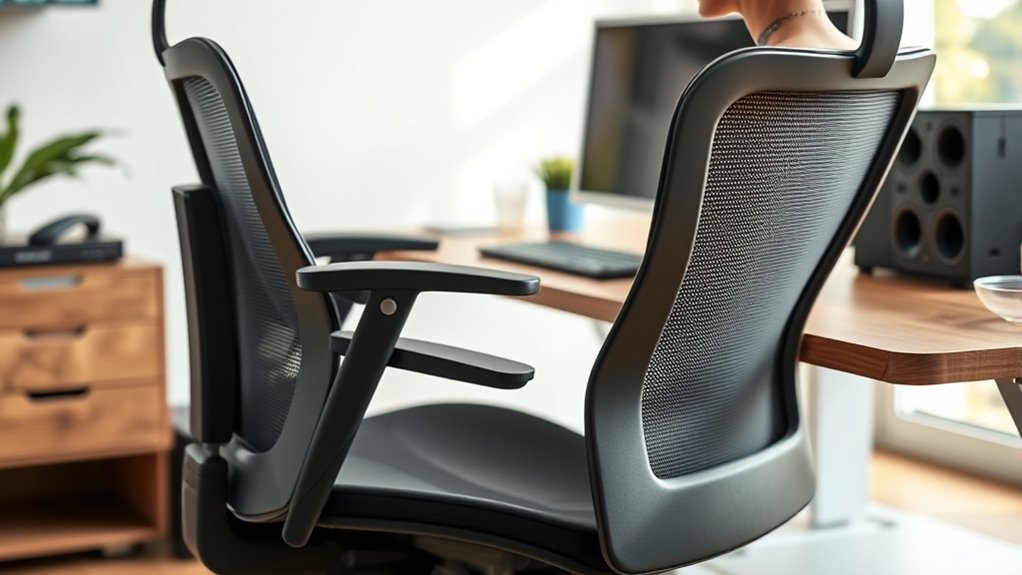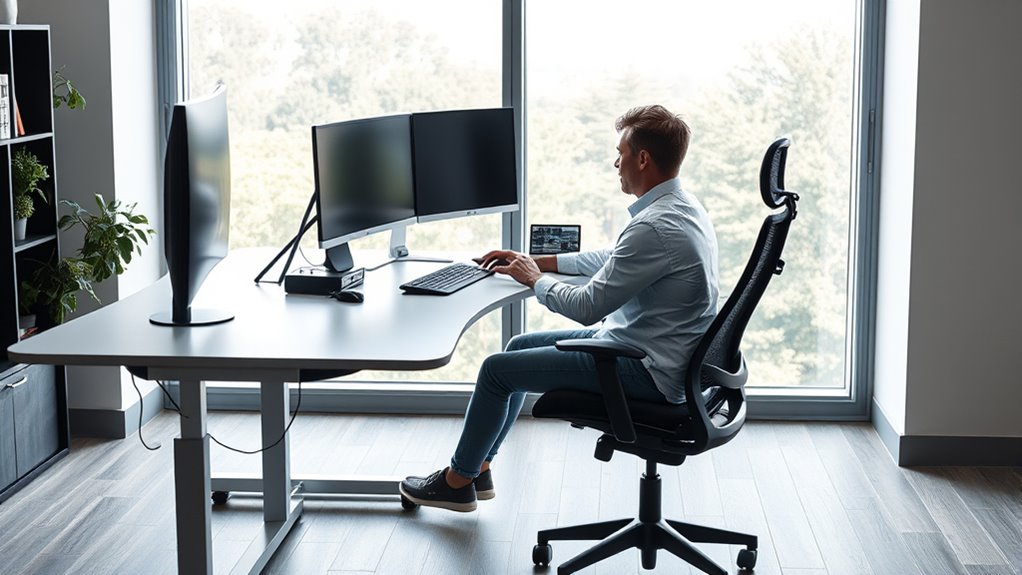Many beliefs about ergonomic desk setups are myths that can lead you astray. For example, sitting in an ergonomic chair alone won’t prevent pain—you need proper positioning and movement. Maintaining your monitor at the right height and distance, adjusting your desk and chair to fit your body, and supporting natural movements with accessories are key. If you explore these truths further, you’ll learn how to create a truly comfortable and healthful workspace.
Key Takeaways
- An ergonomic chair alone doesn’t prevent back pain; proper positioning and movement are essential.
- Desk height should be adjustable, and the keyboard should be at elbow level to avoid strain.
- Monitor placement is about comfort and neutral neck posture, not just eye level alignment.
- There’s no one perfect posture; varying positions and movements promote better ergonomics.
- Ergonomic accessories support natural movements and can significantly improve workspace comfort.
Common Misconceptions About Ergonomic Chairs

Many people believe that simply sitting in an ergonomic chair automatically prevents back pain and discomfort. While these chairs are designed for support, their durability and features matter too. A high-quality ergonomic chair offers better durability, meaning it stays supportive over time, reducing the risk of losing proper alignment. An adjustable lumbar support is essential, as it allows you to customize the chair’s lower back support to fit your spine’s natural curve. Without proper adjustments, even a well-made chair won’t fully protect you from discomfort. Remember, sitting correctly is a partnership between the chair’s design and your habits. Relying solely on the chair’s features without proper positioning or movement can still lead to strain. Ergonomic chairs help, but they’re not a cure-all. Additionally, understanding the beneficial features like adjustable support and quality materials can significantly contribute to the overall effectiveness of your ergonomic setup.
The Truth About Desk Height and Positioning

Although choosing the right desk height is essential for comfort, there’s a common misconception that one fixed position works for everyone. In reality, your ideal setup depends on your body and tasks. You should position your keyboard so it’s at elbow height, preventing strain. Adjust your chair tilt to support a natural seated posture, reducing pressure on your lower back. Remember, a slight tilt can improve comfort without causing wrist issues. To visualize, consider this:
| Adjustment | Recommended Practice |
|---|---|
| Keyboard height | At elbow level, relaxed shoulders |
| Chair tilt | Slight backward tilt for lumbar support |
Your desk setup should be adaptable, focusing on maintaining a neutral, ergonomic position. This minimizes fatigue and maximizes productivity. Additionally, incorporating ergonomic principles into your workspace can further enhance comfort and prevent injury.
Myths Surrounding Monitor Placement

A common misconception about monitor placement is that aligning the top of the screen with your eye level is always ideal. This is one of the common ergonomic myths that many believe. In reality, your monitor should be positioned so that you can view the screen comfortably without tilting your head. The best monitor placement allows you to keep your neck in a neutral position, reducing strain. Some believe that having the monitor directly in front of you is enough, but the distance and angle matter just as much. You don’t need perfect eye-level alignment; instead, focus on a setup that minimizes movement and strain. Remember, ergonomic myths like this can lead to discomfort, so prioritize a monitor position that feels natural and relaxed for your body. Additionally, cultivating attention during setup can help you fine-tune your workspace for optimal comfort.
Debunking the Idea of Perfect Posture

The idea that there is a single “perfect” posture for everyone is a myth that can lead to unnecessary frustration and tension. This misconception stems from posture myths and ergonomic fallacies that suggest one ideal position exists. In reality, your body is adaptable, and what feels comfortable varies from person to person. Focusing on maintaining a static “perfect” posture can cause strain or discomfort over time. Instead, aim for movement and variation throughout your day, adjusting your position as needed. Good ergonomics aren’t about rigid rules but about supporting your body’s natural movements. Recognizing that no one posture suits all helps you avoid unnecessary stress and promotes healthier, more sustainable habits. Flexibility and awareness are key to effective ergonomic practices. Incorporating movement variability into your routine can significantly improve comfort and reduce the risk of strain.
Clarifying Ergonomic Accessories and Their Benefits

Ergonomic accessories are designed to support your body’s natural movements and reduce strain during long periods of sitting. These accessories, like adjustable keyboard stands or wrist supports, can notably improve your comfort. Their benefits include minimizing repetitive strain injuries, promoting better posture, and enhancing productivity. For example, ergonomic accessories focused on keyboard ergonomics help keep your wrists in a neutral position, preventing discomfort and long-term damage. Using the right accessories ensures your workspace aligns with your body’s needs, making it easier to maintain good posture throughout the day. Investing in quality ergonomic accessories is a smart move for anyone seeking a healthier, more comfortable workspace. Additionally, incorporating ergonomics in automation can further optimize your workspace setup by reducing physical strain and improving efficiency. Remember, small adjustments with these accessories can lead to big improvements in your overall well-being.
Frequently Asked Questions
How Often Should I Take Breaks During Desk Work?
You should take a break every 30 to 60 minutes during desk work. This helps with posture correction and reduces eye strain. Stand up, stretch, and move around to prevent stiffness and discomfort. Regular breaks boost circulation and keep you alert. Adjust your workspace to support proper posture, and don’t forget to blink often to lessen eye strain. Consistent breaks are key to maintaining comfort and productivity.
Can Ergonomic Setups Prevent All Types of Back Pain?
Can ergonomic setups prevent all types of back pain? Not entirely, but they substantially reduce your risk. Proper posture correction and chair adjustability play key roles in supporting your spine and reducing strain. Even with a well-designed ergonomic workspace, you might still experience some discomfort if you don’t maintain good habits or take regular breaks. So, focus on adjusting your chair properly and practicing good posture consistently to minimize back pain.
Are Ergonomic Chairs Suitable for Short-Term or Occasional Use?
Ergonomic chairs are suitable for short-term or occasional use, especially if you want to maintain office aesthetics without high cost considerations. They provide comfort and support when needed, helping prevent discomfort during brief periods. However, for long-term use, investing in a more adjustable, high-quality ergonomic chair is better. You can mix and match stylish, budget-friendly options for occasional use while ensuring good posture and comfort.
What Are Signs My Ergonomic Setup Isn’T Working?
If your ergonomic setup isn’t working, you’ll notice discomfort, persistent pain, or fatigue, especially in your neck, back, or wrists. Your posture might be slipping, and you may find yourself leaning or slouching. To fix this, focus on posture correction and make device adjustments like height and angle to guarantee your workspace supports healthy alignment. Regular breaks also help prevent strain and keep your setup effective.
Do Ergonomic Devices Require Professional Assessment or Customization?
A stitch in time saves nine, so don’t overlook your ergonomic needs. You don’t always need a professional assessment or customization for your ergonomic devices, but it can help identify specific issues and prevent discomfort. If you experience persistent pain or discomfort, seeking expert advice ensures your setup meets your unique needs. Customization needs vary, and professional guidance can optimize your workspace, reducing strain and boosting productivity.
Conclusion
Now that you know the facts, creating an ergonomic workspace is within your reach. For example, imagine adjusting your chair and monitor based on proven guidelines—you’re likely to reduce discomfort and boost productivity. Don’t fall for myths like the perfect posture; instead, focus on movement and comfort. By applying these truths, you’ll support your health and work smarter, not harder. Remember, small changes make a big difference in your daily setup.










